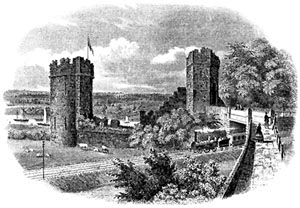  ere
before
us
on
the
north
west
corner
of
Chester's
city
walls,
we
see
the
venerable
sandstone
angle
tower
known
by
the
curious
name
of Bonewaldesthorne's
Tower,
after,
it
is
said,
an
officer
in
the
army
of
Aethelflaed,
daughter
of
Alfred
the
Great,
who
expelled
an
army
of
occupying
Danes
from
the
fortress
in
the
early
10th
century. ere
before
us
on
the
north
west
corner
of
Chester's
city
walls,
we
see
the
venerable
sandstone
angle
tower
known
by
the
curious
name
of Bonewaldesthorne's
Tower,
after,
it
is
said,
an
officer
in
the
army
of
Aethelflaed,
daughter
of
Alfred
the
Great,
who
expelled
an
army
of
occupying
Danes
from
the
fortress
in
the
early
10th
century.
She
went
on
to
rebuilt
and
extended
its
walls
and
establish
Chester
at
the
centre
of
a line
of burghs,
stretching
from Rhuddlan
in
North
Wales
to
Manchester,
to
protect
the
northern
frontier
of
Mercia.
A Saxon
watchtower
would
almost
certainly
have
stood
at
this
strategically
important
location,
but
very
little
of
the
defences
of
that
period
remain
above
ground
today,
and
the
structure
we
see
before
us
is
of
medieval
origin.
Here
is
an
interesting
view
from
the
middle
of
the
19th
century
by
Evans
and
Gresty
showing
an
early
locomotive
passing
under
the
walls
immediately
next
to
Bonewaldesthorne's
Tower.
The
embankment
upon
which
it
runs
is
as
yet
unfenced,
and
cattle
and
sheep
are
placidly
grazing
in
the
meadow
beyond.
The
river
is
busy
with
sail-powered
shipping,
and
beyond
is
nothing
but
fields
and
woods.
Here is
an
interesting
aerial
view
of
the
towers
and
their
surroundings-
a detail
from
John
McGahey's
famous View
of
Chester
from
a Balloon-
as
they
appeared
in
1855.
The
Railway
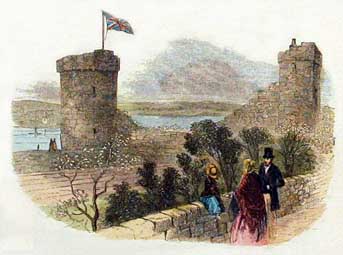 The
first
passenger
railway
service
in
the
world-
that
between
Liverpool
and
Manchester-
opened
in
September
1830, but
the
railway
first
came
the
few
miles
to
Chester
when
the
building
of
the
original
line
from
Warrington
to
Birmingham
in
1837
led
to
an
extension
of
the
line
to
Chester
in
1840.
A line
planned
to
run
from
Chester
to
Birkenhead
never
actually
reached
the
Mersey,
as
there
was
a clause
in
the
Act
of
Incorporation
which
stipulated
that
branch
lines
must
be
built
to
link
with all the
ferries,
if
to
any
at
all,
and
this
proved
to
be
financially
impossible,
there
being
so
many
operating
at
the
time. The
first
passenger
railway
service
in
the
world-
that
between
Liverpool
and
Manchester-
opened
in
September
1830, but
the
railway
first
came
the
few
miles
to
Chester
when
the
building
of
the
original
line
from
Warrington
to
Birmingham
in
1837
led
to
an
extension
of
the
line
to
Chester
in
1840.
A line
planned
to
run
from
Chester
to
Birkenhead
never
actually
reached
the
Mersey,
as
there
was
a clause
in
the
Act
of
Incorporation
which
stipulated
that
branch
lines
must
be
built
to
link
with all the
ferries,
if
to
any
at
all,
and
this
proved
to
be
financially
impossible,
there
being
so
many
operating
at
the
time.
In
1846,
a line
opened
between
Chester
and
Ruabon
in
North
Wales,
and
was
soon
extended
to Holyhead on
the Isle
of
Anglesey (the Welsh call it Ynys Môn),
to
meet
the
boats
for
Ireland.
This
continues
in
service
to
this
day,
and
is
in
fact
the
line
we
see
running
below
us.
Around
thirty
years
later,
in
1875,
the
Manchester,
Sheffield
and
Lincoln
Company
constructed
a new
line
running
from
Manchester
via
Altringham,
Northwich
and
Delamere
to
the
new
Northgate
Station
in
Chester.
In
1890,
the
line
was
extended
to
Shotton,
with
new
stations
at
Blacon
and
Saughall,
and
included
a stretch
which
allowed
trains
from
Manchester
to
bypass
Northgate
station.
This
in
turn
connected
with
others,
allowing
access
to
Hawarden
and
Wrexham,
or
to
Bidston
and
from
there
to
the
popular
resort
of
New
Brighton,
or
to
Birkenhead
and
on
to Liverpool.
Much of this vast labour work was undertaken by the consummate railway engineer Thomas Brassey (1805-1870) who was born at Buerton near Chester. He built many railway stations, including the grand one here in Chester, as well as laying thousands of miles of line not only throughout Britain, but also in France, Italy, Canada, the Crimea, Argentina, Australia, and India. This great man is remembered in his home city merely by a plaque on the station wall and Brassey Street, a little sidestreet near the waterworks in Boughton. A brief biography of Mr Brassey may be found at Wikisource.
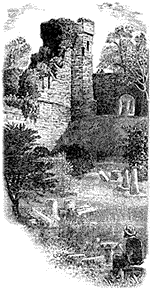 The
upper
floor
of
Bonewaldesthorne's
Tower
houses
a remarkable camera
obscura-
an
ingenious
pre-photographic
optical
device
that
transmits
crystal-clear,
full
colour
images
of
the
surrounding
landscape
via
a movable
lens
mounted
on
the
roof
onto
a table
top
in
a darkened
room
below.
It
was
installed
here
in
the
1830s
when
the
tower
was
taken
over
as
a museum
by
the Chester
Mechanic's
institute,
and
still
functions-
it
was
recently
restored-
a rare
surviving
example
of
this
once-popular
scientific
curiousity.
It
must
be
said,
however,
that,
owing
to
the
proliferation
of
mature
trees
in
the
vicinity,
the
view
is
certainly
not
what
it
once. The
upper
floor
of
Bonewaldesthorne's
Tower
houses
a remarkable camera
obscura-
an
ingenious
pre-photographic
optical
device
that
transmits
crystal-clear,
full
colour
images
of
the
surrounding
landscape
via
a movable
lens
mounted
on
the
roof
onto
a table
top
in
a darkened
room
below.
It
was
installed
here
in
the
1830s
when
the
tower
was
taken
over
as
a museum
by
the Chester
Mechanic's
institute,
and
still
functions-
it
was
recently
restored-
a rare
surviving
example
of
this
once-popular
scientific
curiousity.
It
must
be
said,
however,
that,
owing
to
the
proliferation
of
mature
trees
in
the
vicinity,
the
view
is
certainly
not
what
it
once.
A splendid demonstration of a camera obscura in action features in that great postwar British allegorical film: A Matter of Life and Death starring David Niven, Marius Goring and Kim Hunter.
Passing
right
through
Bonewaldesthorne's
Tower, one
descends
some
worn
stone
steps
and
enters
upon
a spur
wall,
100
feet
long
and
11
feet
wide,
that
connects
the
city
walls
proper
with
the Watertower or New
Tower,
as
it
was
once
also
known.
At 11 feet wide, this is approximately twice as thick as the city wall, and the lowest part is 24 feet above the present ground. The
battlements,
much
reduced
in
height
today,
were
added
in
the
1640s
when,
during
the
Civil
War
Siege
of
Chester,
this
section
of
wall
was
continuously
pounded
by
guns
and grenados (mortars)
situated
on
high
ground
across
the
river,
and
especially
from
a place
called Brewer's
Hall
Farm,
which
you
can
see
on this old
map.
There is a substantial arch through the wall at ground level, and over this there is a small room from which a portcullis may have been raised and lowered.
 At
the
top
of
the
steps
is
a sculpted
stone
niche
within
which
formerly
stood
a statue
of
Queen
Anne by John Tilston-
transferred
here
from
the
old Exchange in Northgate
Street after
this
was
destroyed
by
fire
in
1862.
The
statue
itself
mysteriously
disappeared
sometime
during
the
1960s. Here we see it still in situ in an old photograph. At
the
top
of
the
steps
is
a sculpted
stone
niche
within
which
formerly
stood
a statue
of
Queen
Anne by John Tilston-
transferred
here
from
the
old Exchange in Northgate
Street after
this
was
destroyed
by
fire
in
1862.
The
statue
itself
mysteriously
disappeared
sometime
during
the
1960s. Here we see it still in situ in an old photograph.
River Defences
The
contract
for
the
Watertower's
construction
has
remarkably
survived
and
tells
us
that,
in
the
16th
year
of
the
reign
of
Edward
II,
1322,
the
aptly-named
mason, John
de
Helpeston was
paid
£100
(somewhere
around £250,000 today)
to
build
a
fortified
tower
standing
in
the
River
Dee
west
of
the
existing
fortifications,
together
with
a
connecting
spur
wall.
You
will
recall
from
when
we
visited
the Watergate that
the
river
formerly
flowed
close
by
the
city
walls
and
that
an
important
commercial
and
military
port
thrived
beneath
them.
Until
the
start
of
the
14th
century,
the
existing
structure
of
the
ancient
walls
and
towers
proved
adequate
to
the
port's
defence,
but,
as
the
silting
of
the
Dee
estuary
started
to
badly
affect
the
depth
of
water
available
to
shipping,
it
was
deemed
necessary
to
extend
the
defences
further
out
into
the
river,
and
as
a
result,
this New
Tower was
commissioned.
The contract between him and the city makes it clear that Bonewaldesthorne's Tower ('Turrus de Benewaldestham'), through which the Water Tower is reached, was already in existence.
John
the
mason
did
his
work
well.
The
Watertower
stands
proudly
today
much
as
it
did
when
it
really was the
'New
Tower',
seven
centuries
ago.
It
is
about
75
feet
high
and
its
walls
are
12
feet
thick.
The
lower
chamber
is
a
vaulted
octagon
with
moulded
ribs
rising
from
the
angles
of
the
walls,
with
an
arrow-slit
opening
from
each
recess.
The upper room has only four windows, and that to the right of the entrance is presumably a replacement of the original. The position of the fireplace can still be seen in the west wall. This
upper
chamber-
also
octagonal-
is
reached
via
a
spiral
staircase. To the right of the entrance there was a small latrine. A winding stair to the left leads to the upper room and roof.
The roof parapet still retains much of its crenellations, and overlooking the tower entrance and spur wall there is a raised platform which was originally gained by a continuation of the stair.
Try, as you stand in this peaceful spot,
to
imagine
the
scene
as
early
illustrations
show
it:
of
armed
men
looking
down
to
where
the
Watertower
stood
solidly
in
mid-river
with
wooden sailing ships
moored
to
its
base
and
a
bustle
of
soldiers,
mariners
and
merchants
going
about
their
business
all
around...
Majestic and gay were the vessels adorning
Thy banks, lovely Dee! as I wandered along;
Where I loved to inhale the pure breath of the morning,
And listen with glee to the mariner's song.
How proudly I gaz'd on thy port that was crowded
With barks that were freighted from India's shore;
Nor thought of the time when thy hopes would be clouded,
And commerce and industry bless thee no more! |
Opposite
Bonewaldesthorne's
Tower
there
is
a
gateway
giving
access
to
some
steps
that
take
you
down
to
the
attractive Water
Tower
Gardens,
a
pleasant
little
park,
complete
with
tennis
courts
and
a
popular
bowling
green.
This
area
was
formerly
known
as
the Tower
Field and
in
1836
Hemingway
wrote
that
it
had "recently
been
rented
by
the
guardians
of
the
poor
by
the
cultivation
of
which,
by
spade
husbandry,
able-bodied
paupers
were
very
properly
and
advantagiously
employed".
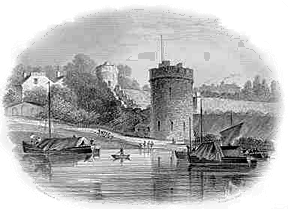 During the Spring and Summer of 2002, the Water Tower Gardens underwent a major facelift- based upon the suggestions of local people and costing around £200,000. Included was the construction of a remarkable two-dimensional maze (one without high surrounding hedges) which consists of coloured paths- the Jubilee colours of red, white and blue- that may be followed, hopefully, to reach the centre. The curves of the maze are said to symbolise the waters of the River Dee, which in medieval times flowed where these gardens now stand. Its designer, Adrian Fisher, explained that "visitors start by choosing one of the three coloured brick strips. Once they start, they they must keep going forwards and not take sharp turns. As they reach each junction square, they are given choices, with two or three directions to choose". During the Spring and Summer of 2002, the Water Tower Gardens underwent a major facelift- based upon the suggestions of local people and costing around £200,000. Included was the construction of a remarkable two-dimensional maze (one without high surrounding hedges) which consists of coloured paths- the Jubilee colours of red, white and blue- that may be followed, hopefully, to reach the centre. The curves of the maze are said to symbolise the waters of the River Dee, which in medieval times flowed where these gardens now stand. Its designer, Adrian Fisher, explained that "visitors start by choosing one of the three coloured brick strips. Once they start, they they must keep going forwards and not take sharp turns. As they reach each junction square, they are given choices, with two or three directions to choose".
Mr Fisher has created more than 200 mazes in 17 countries and has set four Guinness world records. In addition, a fine new community pavilion was opened in the Water Tower Gardens in June 2004.
Looking beyond the park, a very great deal of redevelopment is currently going
on, part of the regeneration of the so-called Old
Port area of the city- which actually dates from the 1730s when the silted-up
river was canalised, new quays and shipyards were established to replace their
land-locked medieval predecessors and New Crane Street was built to link the new
wharves to the city.
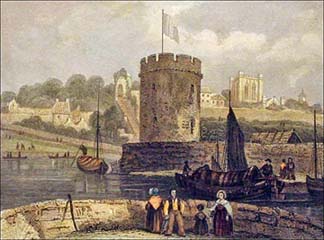 In
the
midst
stands
the
handsome
Victorian Electric
Lighting
Company
Building,
Chester's
first
electric
generating
station,
which
was
built
by
an
enlightened
city
council
in
1896.
It
was,
despite
great
public
opposition,
recently
due
to
be
demolished
to
make
way
for
three
speculative
office
blocks,
a plan
which
was
abandoned
only due
to
a lack
of
prospective
tenants.
A new
housing
scheme
was
then
announced
for
the
site,
but
the
future
of
the
building
remained
uncertain
for
months
until
the
developers,
in
the
face
of
continuing
and
determined
opposition,
agreed
to
incorporate
its
facade
into
their
plans. Read more about it here. In
the
midst
stands
the
handsome
Victorian Electric
Lighting
Company
Building,
Chester's
first
electric
generating
station,
which
was
built
by
an
enlightened
city
council
in
1896.
It
was,
despite
great
public
opposition,
recently
due
to
be
demolished
to
make
way
for
three
speculative
office
blocks,
a plan
which
was
abandoned
only due
to
a lack
of
prospective
tenants.
A new
housing
scheme
was
then
announced
for
the
site,
but
the
future
of
the
building
remained
uncertain
for
months
until
the
developers,
in
the
face
of
continuing
and
determined
opposition,
agreed
to
incorporate
its
facade
into
their
plans. Read more about it here.
Left: the artist of this 19th century watercolour of the Watertower employed a remarkable degree of artistic licence as he happily moved the Cathedral halfway across the city so as to allow it to appear in his painting!
Descending
the
steps
and
entering
the
Watertower
Gardens,
one
may
inspect
the
weathered
base
of
the
old tower
and
its
spur
wall
in
detail.
On
one
side
you
will
see
a
weathered plaque,
erected
in
1730
recording
repairs
carried
out
in
that
year,
during
the
mayorality
of John
Pemberton-
whom
we
shall
meet
again
in
due
course.
Notice
also
the
two
arches
under
the
wall,
beneath
which
small
craft
were
once
able
to
sail-
remember
that
all
this
area
was
once
under
water,
and
that
many
feet
of
these
structures
now
lie
buried
beneath
the
former
mud
of
the
river
bed.
It
was
recorded
that
iron
rings
to
which
ships
moored
were
once
visible
on
the
lower
section
of
the
Watertower,
for
example
by
Fuller,
who
in
concluding
his Worthies of
1662,
vainly
wished, "that
the
distance
between
Dee
and
the
new
tower
may
be
made
up,
all
obstructions
being
removed,
which
cause
or
occasion
the
same;
that
the
rings
on
the
New
Tower
(now
only
for
sight)
may
be
restored
to
the
service
for
which
they were
first
intended,
to
fasten
vessels
thereunto;
that
vessels
on
that
river,
(lately
degenerated
from
ships
into
barks)
may
grow
up
again
to
their
former
state
and
stature".
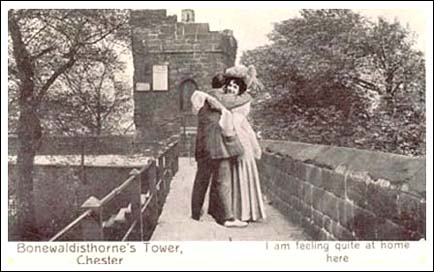 The
international
trade
of
Chester's
port
was
no
doubt
a
contributing
factor
in
the
frequent
outbreaks
of Bubonic
Plague in
the
city.
During
a
severe
attack
following
the
end
of
the
Civil
War,
cabins
were
erected
under
the
Watertower
and
in
a
nearby,
now-vanished,
quarry
and
saltmarshes
to
accomodate
the
afflicted,
in
an
attempt
to
prevent
the
disease
from
spreading. The
international
trade
of
Chester's
port
was
no
doubt
a
contributing
factor
in
the
frequent
outbreaks
of Bubonic
Plague in
the
city.
During
a
severe
attack
following
the
end
of
the
Civil
War,
cabins
were
erected
under
the
Watertower
and
in
a
nearby,
now-vanished,
quarry
and
saltmarshes
to
accomodate
the
afflicted,
in
an
attempt
to
prevent
the
disease
from
spreading.
Part
of
the
great
charm
of
the
Watertower
today
derives
from
the
apparent
lack
of
'improvement'
it
has
undergone-
throughout
the
town,
ancient
structures
have
been
rebuilt-
not
always
necessarily-
or
unsympathetically
'restored',
removing
almost
all
trace
of
their
venerable
origins.
Not
so
here-
when
one
surveys
the
view
at
this
corner
of
the
walls,
despite
the
building
work
in
the
background
and
the
trains
running
beneath,
it
is
easy
to
evoke
the
colourful
and
violent
events
that
have
taken
place
here
throughout
the
centuries.
Recently
the
Watertower-
which
houses
a
most
interesting
little
museum
dedicated
to
the
medieval
port-
underwent
a
programme
of
renovation,
but
for
the
present
sadly
remains
closed
to
visitors,
due,
apparently
to
'funding
shortages'.
I
am
sorry
to
report
that
the
same
excuse
is
given
for
the
closure
of
the Phoenix
Tower on
the
north
east
corner
of
the
walls.
As
we
turn
the
corner
and
pass
over
the
railway,
the
flight
of
steps
on
our
left
leads
us
down
to Tower
Road.
Remarkably,
the
landscaped
area
immediately
below
was
once
occupied
by
public
swimming
baths
and
wash-houses,
established
here
in
1849
and
surviving
until
1892.
In
1882
they
were
supplemented
by
a floating baths
on
the River
Dee-
best
remembered
for
the
occasion
when
it
broke
its
moorings,
drifted
downstream
and
got
stuck
on
the
weir! No
trace
of
either
establishment
survives
today,
but
modern
swimmers
are
well
catered
for
at
the City
Baths on
Union
Street
or
the
much
larger Northgate
Arena.
Now
go
on
to
explore
another
fascinating
part
of
Chester- Tower
Wharf ...
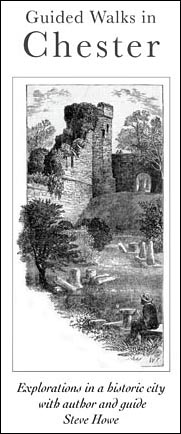 Curiosities
from
Chester's
History
no. 25 Curiosities
from
Chester's
History
no. 25
- For
over
500
years
the
city
executioners
had
made
their
work
a
public
spectacle
on
Gallows
Hill, Boughton (where
St. Paul's
Church
now
stands)
and
the
City
Assembly
had
paid
their
expenses
with
little
comment.
In
later
years
it
had
become
the
custom,
as
an
act
of
mercy
for
those
condemned
to
be
burned
at
the
stake,
for
the
executioner
to
throttle
the
victims
into
insensibility
from
behind,
to
spare
them
the
agony
of
the
fire.
The
Quaker,
Mary
Heald
was
the
last
ever
to
die
at
Boughton
in
this
manner.
- 1766
The
medieval Eastgate,
with
its
two
octagonal
towers
and
battlements,
was
demolished.
In
doing
so,
workmen
discovered
portions
of
the
Roman
Gate-
the Porta
Principalis
Sinistra.
Four
of
the
original
arches
were
discovered
"two
in
a
line
and
fifteen
feet
distant
from
each
other"
and
between
them
a
half-ton
carving
of
Mars,
which
Pennant
recorded
as
"removed
to
the
garden
of
Mr.
Lawton"-
but
since,
unfortunately,
lost.
- 1769
The
new
Eastgate
was
completed
and
the
racecourse
on
the Roodee enlarged,
and
two
stone
Judge's
Chairs
added-
one
of
which
may
still
be
seen
there.
- 1770
One
stagecoach
a
week
travelling
from
Chester
to
London.
The
'Bars'
in
Boughton-
an
outer
defensive
wall
with
a
small
postern
gate,
built
to
defend
the
eastern
entrance
into
the
city-
was
removed.
- 1771
An
Act
was
passed
to
allow
the
building
the
Chester
to
Nantwich
Canal,
and
to
celebrate
this,
the
city
was
illuminated.
95
vessels
came
to
Chester
via
the
new
river
cut.
- 1772
A
"horrid
explosion"
of
800lbs
of
gunpowder
in
Puppet
Show
Entry,
off
Watergate
Street,
on
the 5th
November,
by
which
30
people
attending
a
performance
by
the Sons
of
Mirth
and
Humour in
the
room
above
lost
their
lives
and
"about
70
were
dreadfully
burned".
(Another,
far
better
known,
'Gunpowder
Plot'-
that
of Guy
Fawkes and accomplaces -
had also
taken
place
on
November
5th,
but
167
years
earlier,
in
1605).
The
population
of
Chester
at
this
time
given
by
Pennant
as
being
14,713
- 1773
Chester's
first
public
library
opens
in
St. John
Street. The 'Boston
Tea
Party'
- 1775 The Chester
Chronicle-
still
published
today-
was
established
by
Poole
and
Barker. 1775-83 The
American
Revolution
- 1779 Chester-Nantwich canal built.
- 1781/2 The medieval Bridgegate demolished and replaced by present arch, designed by Joseph Turner.
- 1785 Chester's first hotel, the Royal Hotel built on the site where the present Grosvenor Hotel now stands.
- 1788 The medieval Watergate was demolished and replaced by the present arch, designed by Joseph Turner.
- 1788-1818 The rebuilding of Chester Castle by Thomas Harrison.
|

 ere
before
us
on
the
north
west
corner
of
Chester's
city
walls,
we
see
the
venerable
sandstone
angle
tower
known
by
the
curious
name
of Bonewaldesthorne's
Tower,
after,
it
is
said,
an
officer
in
the
army
of
Aethelflaed,
daughter
of
Alfred
the
Great,
who
expelled
an
army
of
occupying
Danes
from
the
fortress
in
the
early
10th
century.
ere
before
us
on
the
north
west
corner
of
Chester's
city
walls,
we
see
the
venerable
sandstone
angle
tower
known
by
the
curious
name
of Bonewaldesthorne's
Tower,
after,
it
is
said,
an
officer
in
the
army
of
Aethelflaed,
daughter
of
Alfred
the
Great,
who
expelled
an
army
of
occupying
Danes
from
the
fortress
in
the
early
10th
century. The
first
passenger
railway
service
in
the
world-
that
between
Liverpool
and
Manchester-
opened
in
September
1830, but
the
railway
first
came
the
few
miles
to
Chester
when
the
building
of
the
original
line
from
Warrington
to
Birmingham
in
1837
led
to
an
extension
of
the
line
to
Chester
in
1840.
A line
planned
to
run
from
Chester
to
Birkenhead
never
actually
reached
the
Mersey,
as
there
was
a clause
in
the
Act
of
Incorporation
which
stipulated
that
branch
lines
must
be
built
to
link
with all the
ferries,
if
to
any
at
all,
and
this
proved
to
be
financially
impossible,
there
being
so
many
operating
at
the
time.
The
first
passenger
railway
service
in
the
world-
that
between
Liverpool
and
Manchester-
opened
in
September
1830, but
the
railway
first
came
the
few
miles
to
Chester
when
the
building
of
the
original
line
from
Warrington
to
Birmingham
in
1837
led
to
an
extension
of
the
line
to
Chester
in
1840.
A line
planned
to
run
from
Chester
to
Birkenhead
never
actually
reached
the
Mersey,
as
there
was
a clause
in
the
Act
of
Incorporation
which
stipulated
that
branch
lines
must
be
built
to
link
with all the
ferries,
if
to
any
at
all,
and
this
proved
to
be
financially
impossible,
there
being
so
many
operating
at
the
time.